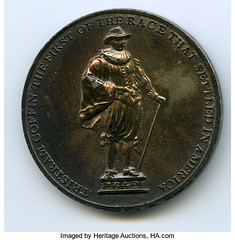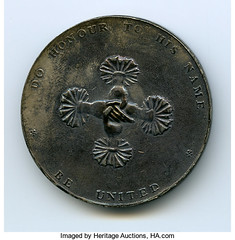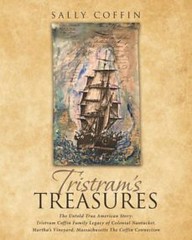
PREV ARTICLE
NEXT ARTICLE
FULL ISSUE
PREV FULL ISSUE
THE TRISTRAM COFFIN MEDALHere's another article I came across while reviewing The Historical Magazine for the Newman Numismatic Portal. Transcribed by NNP's Kelli West, it's about a childhood discovery of a c1826 medal. I added images from Heritage and paragraph breaks for readability. -Editor THE HISTORICAL MAGAZINE.
Notes and Queries.
  THE TRISTRAM COFFIN MEDAL.- Several years ago, I, with some other little boys, was whiling away a summer afternoon, in the delightful employment of digging holes in my father’s door-yard and filling them with water, which holes thus filled we dignified with the name of “wells.” While engaged in excavating a “well” which was to be a grand affair, and which I had already sunk to the depth of a foot or more, I struck upon something smooth and glistening, and soon brought up de profundis a medal of large size which was regarded by us all as an object of great curiosity, and led to many childish speculations as to the manner in which it came to be buried in this locality. Well-digging ceased to interest us from that moment, and we forthwith became a company of money-diggers. Although our further efforts were unsuccessful, yet the appearance of the door-yard when we ceased our operations was more suggestive of a ploughed field than of a well kept grass-plot. My recollection of the appearance of this medal, which I have not seen for twenty five years, is this. On the obverse was the effigy of a man in the dress of a cavalier. The hat on his head was adorned with a feather; the wrists were surrounded with ruffles; the trousers were met at the knee by long stockings; and the feet were enclosed in buckled shoes. The legend was in these words:- “Tristram Coffin, the first of the race that settled in America.” On the reverse were two hands clasped, the wrists ending in ruffles, but the legend if there was any I do not remember. In size the medal was larger than a crown piece, and was struck either in silver, tin or white medal. At that time a young man by the name of Coffin was a clerk in my father’s office, and to him, on my father’s suggestion, I gave the medal. Since then I have often made inquiries as to the origin and history of this memorial piece, but have never yet seen a satisfactory account of it. That Tristram Coffin was the first of his race that settled in America, there can be no doubt. In the second volume of the New England Genealogical Register may be found statements respecting his history, and in Dr. F. B. Hough’s compilation of “Papers relating to the island of Nantucket,” a copy of his signature is given, several of his letters are presented, and his importance as one of ten owners of Martha’s Vineyard and as a local magistrate is recorded. If my friend who has the piece which rewarded my early efforts in well-digging, or if any of your readers can throw light on this subject, the information will afford me much pleasure. B.H.H.
To read the Heritage lot description, see:
John Sallay writes: "I don’t know much about this medal beyond the excellent history put together by John Kraljevich in his cataloguing of the LaRivierre Collection pieces (Part II, Bowers & Merena, March 16, 2001, lots 2128 and 2129). "I never really thought of this as a school medal, but having now just re-read John’s description I probably ought to start keeping my eyes open for a nice copper example, which John says were distributed to scholars at the Lancastrian school on Nantucket." John Kraljevich writes: "Not only do I love this medal, I’m also a Tristram Coffin descendant! "Be aware there are different generations of these things. The struck AE originals by Thomason are from 1827 - I know of a gilt AE in a presentation box too (ex LaRiviere, now CWF). But family reunions on Nantucket distributed cast copies from the late 19th through early 20th century - these are pretty obviously cast. I have several different generations in my own collection. At one point I had 2 original strikings in stock and nobody wanted them. I think I ended up selling both for a loss. Pity too - they’re rare medals!" John Adams writes: "Thirty years ago, my neighbor down the block was Tristram Coffin, a direct descendant. I sold him my medal and later bought another." How cool is that? Thanks, everyone. -Editor To read the LaRivierre Collection collection lot descriptions, see the Newman Numismatic Portal (page 211-212):
For more information on Tristram Coffin, see:
 Wayne Homren, Editor The Numismatic Bibliomania Society is a non-profit organization promoting numismatic literature. See our web site at coinbooks.org. To submit items for publication in The E-Sylum, write to the Editor at this address: whomren@gmail.com To subscribe go to: https://my.binhost.com/lists/listinfo/esylum All Rights Reserved. NBS Home Page Contact the NBS webmaster 
|
